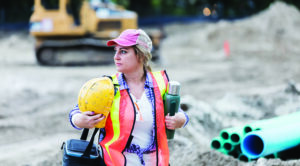
To change an industry
By Danielle Fenn
Construction Health & Safety Labour Women in ConstructionHow to build a safe and inclusive working environment.
With long hours that don’t easily match childcare schedules, gear that is not always available in proper sizing, and even a basic lack of private washrooms, construction is not an easy industry for women. A recent industry survey indicated that only 42 per cent of women felt welcome when they joined the industry. A similar number felt isolated on their crew because of their gender, and 70 per cent experienced harassment or were actively concerned about their safety while at work.
In today’s economic and labour environment, construction firms need to make changes to address such issues, especially since the industry is expecting the labour shortage to only worsen.
Unfortunately, when they step onto the job site, many women will still find they are the only female around. Statistics Canada suggests that roughly seven per cent of construction workers in Canada are female, but the actual figures are closer to the three to five per cent range.
Despite the challenges, there has never been a better time for women to enter the construction industry. Government programs and interest groups are actively encouraging women to join an industry that is growing in an economy that seems to be shrinking.
Construction firms that want to recruit and retain enough female workers to combat the labour shortage will need to recognize the critical role that workplace culture plays, and how a poor culture can drive women away from a company, and even the industry. Actively creating an inclusive environment offering equal opportunities for men and women on the job site is a critical component of being an employer of choice.
The good news is that creating an inclusive culture may be easier than you think. It starts with a basic foundation of respect, and is enhanced by meeting each individual employee’s needs.
PPE CONSIDERATIONS
Personal Protective Equipment (PPE) is not “one-size-fits-all.” Remember that PPE is intended to protect workers from injury and other hazards. Offering men’s PPE to female workers compromises their safety since the sizing can be all wrong. Even worse, women who make do with the wrong PPE often find it difficult to do their jobs effectively.
PPE based on female anthropometric data is available from a number of suppliers, however. As a best practice, contract with PPE vendors that offer a wide range of equipment for both men and women, and keep a close eye on supply to ensure that appropriate PPE is available as needed.
FOCUS ON ERGONOMICS
Women are three times more likely to be injured on the job compared to men, and some of these injuries are linked to women using equipment that wasn’t designed for their bodies. They come to the workplace with a different set of personal risk factors, including medical conditions, personal fitness and even medications that can influence the possibility of ergonomic injury.
Best practice calls for the use of a variety of tactics, from workplace monitoring and body mechanics training, to pre-shift exercises, to prevent ergonomic injuries. Consider providing female workers with tools that can be adjusted for women’s bodies, and developing safe lifting guidelines that are appropriate for women.
OFFER CLEAN WASHROOMS
At many small job sites, a single unisex portable washroom is the norm, and it may not be well-maintained. For women working at a site like this, the choice is (at best) an awkward one. Use the facility and risk contact with a contaminated seat, or not use the facility and risk health problems.
Ontario recently announced it will be requiring separate women’s washrooms on job sites. Washrooms must be private, properly lit and include hand sanitizer when running water is not available.
RAISE AWARENESS AROUND RISKS
Construction sites are home to a variety of hazards, many of which could impact not only a woman’s health overall but also her reproductive health. Whether it’s ongoing exposure to chemicals or simply movement that might be too strenuous in a later stage of pregnancy, it’s important to understand the risks, and mitigate them where possible.
Organizations should also note that every situation is different. Women in the construction industry must share information about their workplace hazards and challenges with their family doctor to determine what is right for them, and organizations must be ready to make accommodations, when necessary. This includes for women who may struggle to perform their regular duties during later stages of pregnancy. Keep in mind that properly fitting PPE, while important for everyone, is especially important for women who are expecting.
CREATING THE RIGHT ENVIRONMENT
Women in construction are largely positive about their experience, but they also recognize best practices to make their experience even better: more support, respectful management and more mentorship.
Breaking down a “macho” culture starts with small steps, all related to increasing respect. Women today expect fair and equal treatment, including pay equity. Similarly, female employees should be able to come to work and feel safe. They should be comfortable to report unwanted behaviour or other concerns to their managers, without worry that reporting their concerns will impact their job opportunities. In addition, it should go without saying that sexual harassment must not be permitted.
A safe and inclusive culture is key for any industry to maintain a successful workforce, but it also brings additional benefits, including increased innovation, higher engagement, better decision-making skills, reputational enhancement, and more.
Danielle Fenn is senior vice-president in the construction practice for insurance brokerage Hub International.





